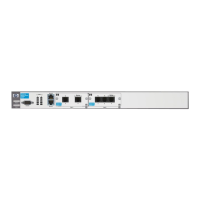10-17
Bridging—Transmitting Non-IP Traffic or Merging Two Networks
Configuring Spanning Tree
For example, in Figure 10-5, a connection is added between Bridge B and the
root. The root bridge first asserts sync with Bridge B. Bridge B blocks its
connection to Bridge A. Bridge B attempts to assert sync with Bridge A, but
Bridge A rejects the offer because it has a better connection to the root. The
link between Bridge A and Bridge B remains blocked.
Immediate Purging. In STP, when devices receive a TCN BPDU withdraw-
ing an entry, they set the timer for the entry in the database to short. Only when
this timer expires do they flush the entry. In RSTP, devices purge old informa-
tion as soon as they receive a BPDU indicating a topology change.
RSTP and STP Compatibility
RSTP is designed to be compatible with STP. Even if the LAN is using STP, you
should enable RSTP on your router. RSTP automatically detects ports con-
nected to non-RSTP devices and communicates with those devices using
802.1D STP BPDU packets.
Because RSTP is so much more efficient at establishing the network path, it
is highly recommended that all your network devices be updated to
support RSTP.
Configuring RSTP
RSTP is automatically activated on these interfaces when they act as
bridge ports:
■ Ethernet interfaces
■ Frame Relay subinterfaces
■ ATM subinterfaces
You should typically run a spanning tree protocol on these interfaces to
prevent the router from handling more traffic than it must. PPP and HDLC
interfaces do not participate in the spanning tree.
For most networks, RSTP runs smoothly without any further configuration.
However, you can also:
■ set the router’s priority to influence the election of the root device
■ set link cost to influence the selection of a link
■ set roles for interfaces
■ alter timers

